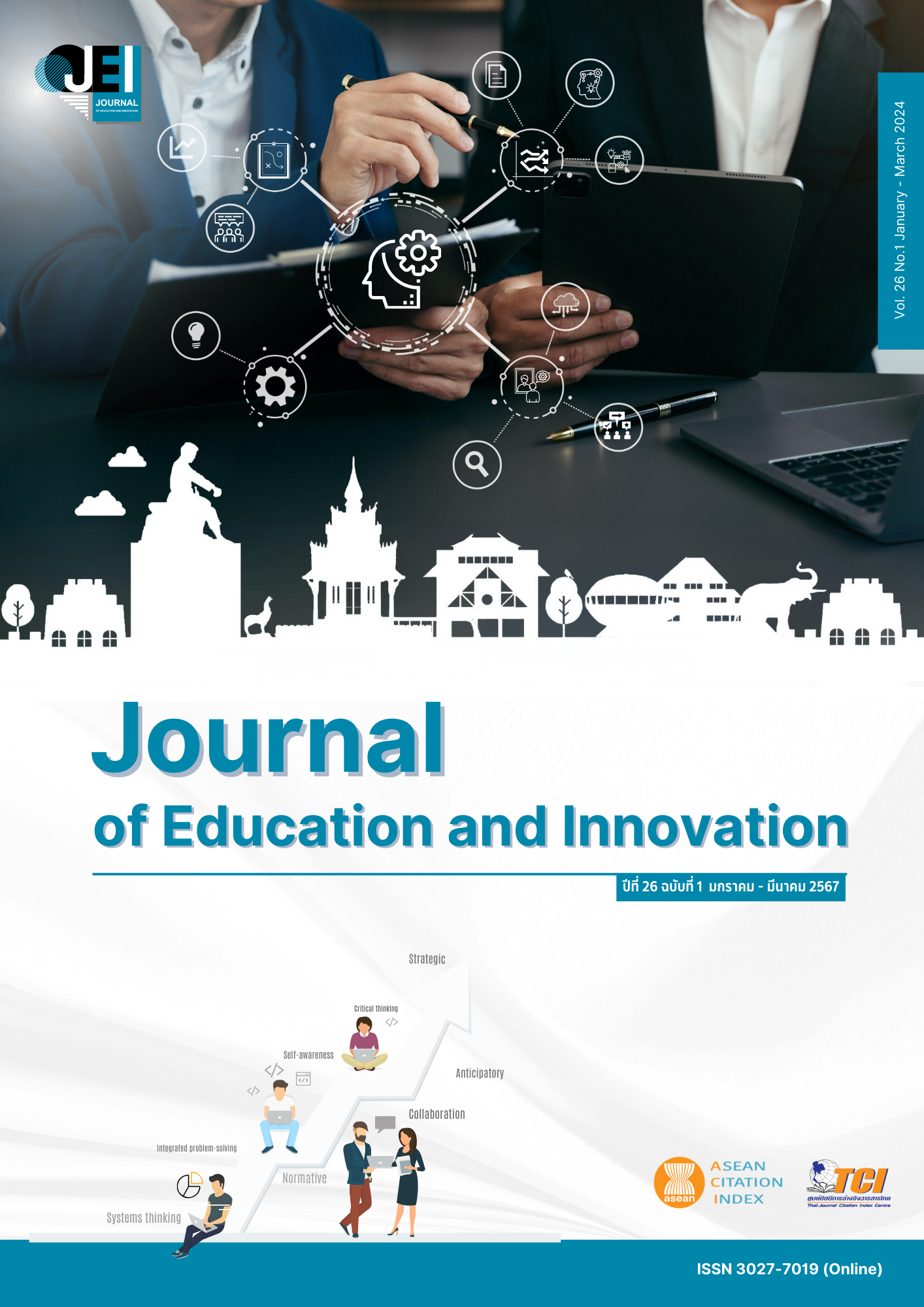THE APPLICATION OF VIRTUAL REALITY TECHNOLOGY TO ENHANCE EDUCATION IN THE AGE OF NEW NORMAL
Main Article Content
Abstract
The objectives of this research aimed to 1) study formats of virtual reality learning, 2) study the uses and gratification of lecturers towards virtual reality technology, and 3) study the advantages and barriers of virtual reality technology used for learning for further applications in the new normal education. This study was qualitative research. The sample group of university lecturers was selected through purposive sampling using an interview form. The results indicated that virtual reality technology consists of 4 formats: 1) Sense of experience, 2) Content, 3) Code, and 4) Context of Use. Users of virtual reality technology for new normal learning can be categorized into two groups based on their uses and gratification: 1) Cognitive needs group and 2) Affective needs and Tension Release needs group. The advantages of virtual reality technology were: 1) Virtual reality technology helps to enhance knowledge and imagination of users with 3D, 360 degrees, omnidirectional visual, and 2) Virtual reality technology can be used nearly at any time and place. In contrast, the barriers were 1) Lack of knowledge and understanding of devices’ usage instruction, and 2) Educational institutions are still unaware of the benefit and crucial roles of virtual reality technology in education.
Article Details

This work is licensed under a Creative Commons Attribution-NonCommercial-NoDerivatives 4.0 International License.
The owner of the article does not copy or violate any of its copyright. If any copyright infringement occurs or prosecution, in any case, the Editorial Board is not involved in all the rights to the owner of the article to be performed.
References
Bojakkrapan, S., Treerat, T., Srikhwang, S. and Kasabai, P. (2016). The Development of an Interactive Edutainment Virtual Reality Exploring the Solar Systems. Retrieved June 18, 2022, from https://dspace.bru.ac.th/xmlui/bitstream/handle/123456789/2083/
Chaisungnoen, V. (2004). Playing behavior and building of virtual imagination: the impact of the game-online Ragnarok to teenagers (Master thesis). Bangkok: Chulalongkorn University.
Dainton, M., & Zelley, E.D. (2011). Applying communication theory for professional life: A practical introduction. (2nd Ed.) Thousand Oaks, CA: Sage Publications.
Davis, S. B. (1996). The Design of Virtual Environments with Particular reference to VRML. Retrieved July 18, 2022, from https://www.entrepreneur.com/article/248578
Di Serio, A., Ibanez, M. B., & Kloos, C.D. (2013). Impact of an Augmented Reality System on Student’s motivation for a visual art course. Computer & Education, 586-596.
Dominick, J. R. (1990). The Dynamics of Mass Communication. New York: McGraw-Hill.
Jantakoon, T. (2018). Virtual Immersive Learning Environment Based on Digital Storytelling to Enhance Deeper Learning for Undergraduate Students (Doctoral dissertation). Bangkok: King Mongkut’s University of Technology North Bangkok.
Katz, E., Blumler, J. G., & Gurevitch, M. (1974). Utilization of Mass Communication by the Individual. In J. G. Blumler & E. Katz (Eds.), The Uses of Mass Communications: Current Perspectives on Gratifications Research. Beverly Hills CA: Sage Publication.
Klinsungnoen, S., Tuntiwongwanich, S., & Petsangsri, S. (2015). Development of Augmented Reality on Computer Operation for Grade 7 Students. Journal of Industrial Education, 14(3), 293-294.
Kukeatnun, K. (2009). The Exposure, Usage and Gratification of the Audiences in Bangkok towards Kui Kuy Khao News Program (Master thesis). Bangkok: Thammasat University.
McCombs, M. E., & Becker, L. B. (1979). Using mass communication theory. Englewood Cliffs: Printice Hall.
McQuail, D. (2010). McQuail’ s mass communication theory. London: SAGE Publication.
Naksukpan, C. (2014). Exposure, Perception, Use and Gratifications towards WOMAN AND WOMAN TV Program of the Audience in Bangkok (Master thesis). Bangkok: Dhurakij Pundit University.
Pongsukvajchakul, P. (2011). New Media Technologies and Communication in Thai Families in Bangkok Metropolitan (Doctoral dissertation). Bangkok: Dhurakij Pundit University.
Singhnet, S. (2005). Sale of Sex Service through Internet Chat Rooms (Master thesis). Chiang Mai: MaeJo University.
Srifah, D. (2019). Virtual Reality for Tourism Promoting of Koh Pha-ngan. (Master thesis). Bangkok: Rajamangala University of Technology Phra Nakhon.
Supthaworn, M. (2002). A Comparison of Free and Limited Movement Control in Virtual Reality Lessons on Web Upon Understanding in Learning Biology Subject of Mathayomsuksa four Student (Master thesis). Bangkok: Chulalongkorn University.
Sutherland, I. E. (1965). The Ultimate Display. Proceeding of IFIPS Congress, New York, May 1965, Vol.2, 506-508.
Udomkasemsap, P. (2017). Virtual Reality for Touring Case Study of Hua-Hin Tourism Promote (Graduate School). Bangkok: Bangkok University.
Wyatt, S. (2008). Technological Determinism is Dead; Long Live Technological Determinism. Retrieved May 14, 2022, from https://www.researchgate.net/publication/261947854


